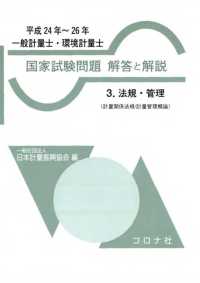Full Description
As the name of the book itself suggests, this book intends to lay a conceptual, scientific, evidence-based firm basic foundation as well as advanced learning for a doctor who wishes to either start a career as an Orthopod or already pursuing it (MS/ DNB/ Senior Resident/ Registrar/Fellow/ Consultant) or has Orthopaedics as a part in his career (MBBS/ Paramedical) as a doctor or paramedical personnel. This book is a foundation study for Orthopaedics of MBBS students. It covers theory and the clinical aspects which a student pursuing his MBBS degree in an autonomous institute of national importance, i.e., AIIMS & AIIMS-like institutions of India, must know about and pass with excellent and concise knowledge of Orthopaedics. This book focuses on laying a sound foundation for beginners in Orthopaedics. This book shall be helpful as first read to lay a basic knowledge and foundation of Orthopaedics to Orthopaedics postgraduate trainees, senior residents, fellows, and attending consultants. The importance of Orthopaedics is more than ever now in MBBS as well as during NEET/NEXT. Many institutes and colleges are already conducting the Orthopaedics exams in MBBS as a separate, independent subject. Hence, there is an urgently emerging need for a textbook adherent to the recommended curriculum, and this book shall be more apt, appropriate, and detailed than any book available in the country. The book covers all the standard topics important for an undergraduate to learn and an intern to practice. It also provides an introduction to recent advances and evidence-based medicine. This book is a total package as a textbook for all the necessary information required for a successful undergraduate and an early postgraduate trainee.
Contents
Chapter 1: Anatomy of bone.- Chapter 2: Biochemistry of bone.- Chapter 3: Fracture healing.- Chapter 4: Amputations.- Chapter 5: Prosthetics and Orthotics.- Chapter 6: Introduction to Evidence Based Medicine.- Chapter 7: Common terminologies and classification of fractures.- Chapter 8: Open fractures.- Chapter 9: Pathological fractures.- Chapter 10: Dislocations and Subluxations.- Chapter 11: Injuries to ligaments, muscles and tendons.- Chapter 12: Polytrauma.- Chapter 13: Recent concepts in fracture treatment.- Chapter 14: Complications of fractures.- Chapter 15: Fractures in children.- Chapter 16: Approach to a patient with limb injury.- Chapter 17: Introduction to functional bracing and distraction osteogenesis.- Chapter 18: Injuries around the shoulder.- Chapter 19: Injuries of Arm.- Chapter 20: Injuries around Elbow.- Chapter 21: Injuries of the Forearm.- Chapter 22: Injuries of the Wrist.- Chapter 23: Hand injuries.- Chapter 24: Fractures and dislocations around the Hip.- Chapter 25: Femur fracture.- Chapter 26: Injuries around Knee.- Chapter 27: Fractures of the Tibia and Fibula.- Chapter 28: Ankle injuries.- Chapter 29: Foot injuries.- Chapter 30: Pelvis injuries.- Chapter 31: Spine injuries and Traumatic Paraplegia.- Chapter 32: Brachial plexus injuries.- Chapter 33: Peripheral nerve injuries.- Chapter 34: Acute Osteomyelitis.- Chapter 35: Chronic and Subacute Osteomyelitis.- Chapter 36: Septic Arthritis.- Chapter 37: Rare infections.- Chapter 38: Leprosy.- Chapter 39: Tuberculosis of Spine and Pott's Paraplegia.- Chapter 40: Tuberculosis of Hip.- Chapter 41: Tuberculosis of knee and other joints.- Chapter 42: Tubercular Osteomyelitis.- Chapter 43: Tuberculous Infections of the Hand.- Chapter 44: Congenital Talipes Equino Varus.- Chapter 45: Developmental Dysplasia of Hip.- Chapter 46: Cerebral Palsy.- Chapter 47: Poliomyelitis.- Chapter 48: Spina Bifida.- Chapter 49: Muscle dystrophies and myopathies.- Chapter 50: Perthes Disease.- Chapter 51: Torticollis.- Chapter 52: Slipped capital Femoral Epiphysis.- Chapter 53: Deformities around Knee.- Chapter 54: Pes Planus.- Chapter 55: Pes Cavus.- Chapter 56: Classification of bone tumors.- Chapter 57: Approach to a patient.- Chapter 58: Benign Bone Tumors.- Chapter 59: Malignant Bone Tumors.- Chapter 60: Metastasis.- Chapter 61: Approach to patient with back pain.- Chapter 62: Intervertebral Disc.- Chapter 63: Scoliosis and Kyphosis.- Chapter 64: Thoracic Outlet Syndrome.- Chapter 65: Approach to a patient with Polyarthralgia.- Chapter 66: Rheumatoid Arthritis .- Chapter 67: Ankylosing Spondylitis.- Chapter 68: Soft tissue affections of Upper Limb and Lower Limb.- Chapter 69: Osteoarthritis.- Chapter 70: Spondylosis and Lumbar Canal Stenosis.- Chapter 71: Rickets and Osteomalacia.- Chapter 72: Osteoporosis.- Chapter 73: Hyperparathyroidism.- Chapter 74: Fluorosis.- Chapter 75: Gout.- Chapter 76: Total Joint Replacement.- Chapter 77: Partial Knee Replacement.- Chapter 78: Shoulder, Elbow and Ankle Replacement.- Chapter 79: Introduction to Arthroscopy.- Chapter 80: Introduction to Endoscopy in Spine.








